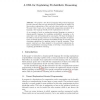Free Online Productivity Tools
i2Speak
i2Symbol
i2OCR
iTex2Img
iWeb2Print
iWeb2Shot
i2Type
iPdf2Split
iPdf2Merge
i2Bopomofo
i2Arabic
i2Style
i2Image
i2PDF
iLatex2Rtf
Sci2ools
106
click to vote
DSL
2009
2009
A DSL for Explaining Probabilistic Reasoning
We propose a new focus in language design where languages provide constructs that not only describe the computation of results, but also produce explanations of how and why those results were obtained. We posit that if users are to understand computations produced by a language, that language should provide explanations to the user. As an example of such an explanation-oriented language we present a domain-specific language for explaining probabilistic reasoning, a domain that is not well understood by non-experts. We show the design of the DSL in several steps. Based on a story-telling metaphor of explanations, we identify generic constructs for building stories out of events, and obtaining explanations by applying stories to specific examples. These generic constructs are then adapted to the particular explanation domain of probabilistic reasoning. Finally, we develop a visual notation for explaining probabilistic reasoning.
DSL 2009 | Generic Constructs | Particular Explanation Domain | Probabilistic Reasoning | Programming Languages |
Related Content
| Added | 17 Feb 2011 |
| Updated | 17 Feb 2011 |
| Type | Journal |
| Year | 2009 |
| Where | DSL |
| Authors | Martin Erwig, Eric Walkingshaw |
Comments (0)

